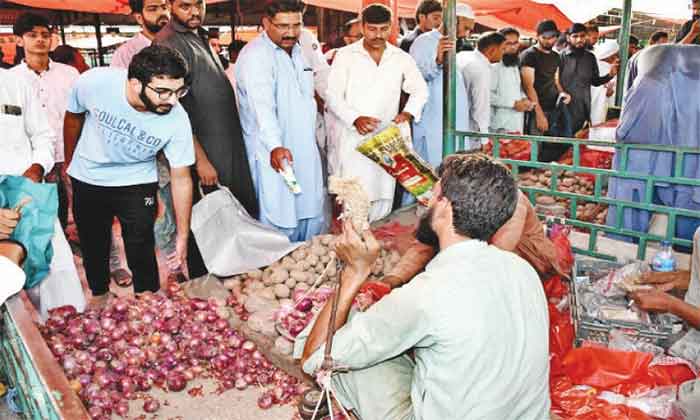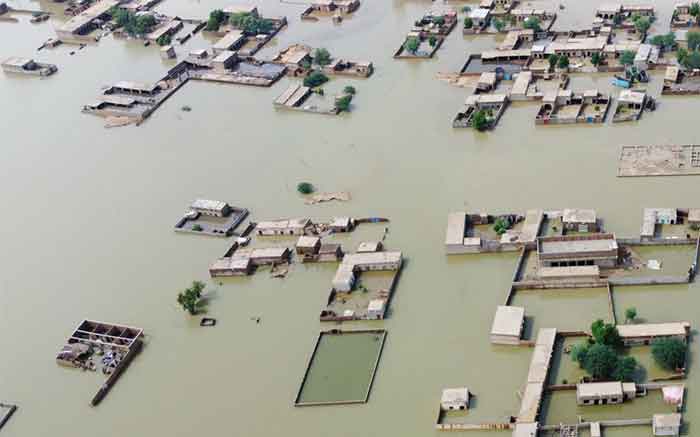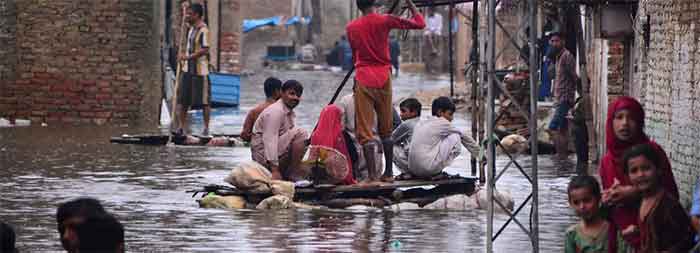
Skyrocketing prices of tomatoes, potatoes and onions are putting food out of reach in flood-ravaged Pakistan, raising the specter of inflation hitting 30% that may spur more monetary tightening, said a report.
The Bloomberg report said:
The South Asian nation already reeling from dwindling currency reserves and the fastest inflation in almost five decades faces a food shortage after torrential rains submerged a third of the country and destroyed crops. Eight more districts were added at the weekend to the country’s calamity list of 80 areas hit by floods.
Onions were sold at 300 rupees ($1.37) a kilo from 50 rupees before the floods, according to Ali Asghar Londer, one of the thousands living in evacuation tents in Dadu, a city near the western bank of the Indus River. Dadu has seen the biggest damage to its rice and onion production.
The cost of potatoes have climbed four times to 100 rupees a kilo, tomatoes were up by 300% to 400 rupees a kilo, while Ghee, a fat used for cooking, has surged 400%, Londer said last week. Elsewhere, supplies of dairy and meat were also hit as warehouses got flooded.
The report said:
The surge in food prices will add stress to an already fragile and politically divided economy that has just been regaining some funding strength after securing a $1.16 billion International Monetary Fund bailout and $9 billion in pledges from Qatar, Saudi Arabia and the UAE.
The floods, which will cost an estimated $10 billion worth of damage, has claimed the lives of more than 1,300 people and forced half a million into camps. It’s also submerged large swathes of farmland and flushed away crops in a country where agriculture accounts for about a fifth of the economy.
Inflation Impact
The report added:
While Finance Minister Miftah Ismail was sanguine on Sept. 3, saying vegetable prices are coming off and that inflation at a 47-year-high is close to its peak and likely average at 15% this year, analysts weren’t as optimistic.
“The main concern from the floods is the impact on inflation,” said Amreen Soorani, head of research at JS Global Capital Ltd. “Food shortage from floods the last time in 2010 almost doubled food inflation in two months. We’re already in a high inflationary environment, making the scenario even more difficult.”
Consumer price gains quickened to 27.26% in August, rising for a sixth straight month before the full impact of the flooding is felt. Food inflation, that makes up a third to the basket, climbed to 29.5% last month. The calculus doesn’t include yet the full impact of energy prices rising by 50%, a condition of the IMF loan.
Inflation could accelerate to 30% in the coming two months and that would take the average price gains this fiscal year to 23%-24%, surpassing the central bank’s estimate of 18%-20%, according to Fahad Rauf, head of research at Ismail Iqbal Securities Pvt.
Former premier Imran Khan, who was ousted in April yet remains very popular, is waging a fierce campaign to press for elections, and the devastating floods is stoking public anger.
“It has been four days that our children are sitting on the road awaiting food and shelter. Our children are dying,” said Mohammad Sharif, 40, a protest leader who last week blocked one of the nation’s main highways for a few hours after not getting any relief goods. “We have no food, no tents, nothing.”
Deadly Floods Inundate Farms in Pakistan, Flushing Away Crops
Another earlier report by Bloomberg said:
The toll of extreme flooding on Pakistan’s food security is becoming apparent: large swathes of farmland under water, crops and stockpiles washed away, homes and livelihoods wiped out.
The government warned that a food crisis is looming. Rains and deadly floods have damaged rice and cotton crops, along with vegetables like onions and tomatoes. They also threaten wheat planting in the coming months at a time when the world can ill afford another disruption to grain supply.
Global prices of kitchen staples soared following Russia’s invasion of Ukraine, driving food inflation to a record. The catastrophic flood could be a $10 billion hit to a Pakistan economy already in crisis. The damage to food supplies will probably boost the nation’s need for imports and increase the pressure on global agricultural markets.
Maula Bux, 24, was helping his father, a farmer in Sindh province, push a boat carrying 60 kilograms of wheat through knee-deep water. They’re moving the grain from their flooded mud house to a tent the family is now living in.
“We stored about 50 bags of wheat at home but at least 40 of them got wet. We were barely able to save these few bags for our family’s consumption,” he said. “There is no ration shop here. What will we do? What will we eat?”
Pakistan, among the most vulnerable globally to climate change, has seen the highest rainfall in at least three decades. About a third of the country is currently flooded, the government estimates, and about 1,200 people have lost their lives. Around 40% of the labor force rely on agriculture for employment, while the sector represents about a fifth of the economy.
“The agricultural sector is in turmoil. The cotton crop and vegetables are completely wiped out in many key areas,” said Pakistan Businesses Forum Vice President Ahmad Jawad, who grows wheat, maize, citrus and sugarcane. “Wild weather just can’t give us a break. First the heat wave, now floods.”
As much as half of Pakistan’s cotton crop has been damaged by the torrential rains, Planning Minister Ahsan Iqbal said on Tuesday, citing preliminary estimates. The country is the fifth-largest cotton producer, accounting for 5% of global output. The damage could further shrink the world’s cotton supply.
Food costs have jumped in Pakistan, with tomato prices surging fivefold and onions tripling since last month. Steps are being taken to import vegetables and other items from Iran and Afghanistan. Pakistan is also considering a temporary land route to allow duty-free shipments from arch-rival India.
“The two neighboring countries have issues but a humanitarian crisis comes first,” Jawad said. “India has a surplus of vegetables so it’s a win-win.”
International aid is also trickling in. The World Food Programme is working to expand food assistance to Pakistan, aiming to reach about half a million people in the badly-hit provinces of Balochistan and Sindh.
Along the Indus Highway, which leads to Karachi, dozens of trucks loaded with relief goods were seen heading to the flood-hit areas, with some throwing packets of food to children.
Still, floodwaters are restricting access across the country, with more than 100 bridges and about 3,000 kilometers (1,864 miles) of roads damaged or destroyed. Almost 800,000 farm animals have perished, and 2 million acres of crops and orchards have been hit, according to the United Nations.
“The floods have broken multiple bridges so supplies from Iran will not reach Pakistan’s main population center in Punjab province,” Jawad said. “Indian imports are needed to help bring prices down.”
Pakistan already has one of the fastest inflation rates in the region, with consumer price gains rising to a 14-year high of almost 25% in July. The August print is due for release on Sept. 1.
Sowing next year’s wheat crop, which starts in October, will be another challenge. Pakistan is already in talks with Russia over importing wheat, Prime Minister Shehbaz Sharif said last month in parliament. Even before the floods, the country was facing a wheat shortage of about 2.6 million tons.
The direct crop loss to flood damage is $2.3 billion, according to an estimate by Uzair Younus, director at the Atlantic Council’s Pakistan Initiative and economist Ammar Khan.
BALOCHISTAN’S FIELDS OF THE DEAD
A report by The Dawn (Pakistan, September 4, 2022) said:
A bent, green signboard on one side of the Quetta-Karachi highway directs us towards Gongo Goth Piperani in Bela town of Lasbela district, which has been battered by unprecedented torrential rains and floods.
Lasbela is one of the worst hit districts in Balochistan. The Provincial Disaster Management Authority (PDMA) put the death toll at 27, while data obtained from the Deputy Commissioner’s Office suggests six people have been injured, 5,000 to 8000 houses damaged, 87,345 livestock lost and 57,450 acres of crops have been damaged so far. The towns of Bela, Uthal, Hub and Durreji, among others, have suffered massive destruction.
From the highway, an unpaved road snakes through lush green fields — mostly of cotton and vegetables — dotted with shrubs and trees. Gongo Goth Piperani, like other villages across Lasbela has been washed away; the mud and hut houses left standing are few and far between.
After a 15-minute drive, a mud house appears. It belongs to a family mourning the death of four loved ones: Yar Mohammad Sabira, 40, drowned, along with his wife Naz Jan, in her 30s, and two children, eight-year-old Zainab and seven-year-old Yousaf.
The grief-stricken family is not new to such loss. Some 15 years ago, the mother and sister of Yar Mohammad both drowned in Karachi’s Lyari river. But the fresh pain of losing Yar Mohammad, his wife and kids has multiplied to envelop the whole of the district, which is on the brink of collapse due to floods.
A neighboring district of Karachi, Lasbela is a kind of “mini Balochistan”, where coast, mountains, plains and rivers meet, and deposits of various minerals are found. Agriculture is one of the main forms of subsistence here.
Situated at a distance of around 10 hours drive from Quetta on the N-25 highway, Lasbela district is home to Balochistan’s former chief minister Jam Kamal, whose family has produced a line of chief ministers. Though it is home to such an influential political family, like other parts of Balochistan, governance exists only in name here. According to the locals in Piperani, there is still no electricity in the villages here. After the floods, it is no more than a wasteland.
I offer fateha (funeral prayers) for Yar Mohammad and afterwards talk to Atta Mohammad, his elder brother. We go to his father’s house, where he begins to tearfully recall the day when the floodwaters took away his brother and his family. “It was four o’clock in the morning,” he tells Eos, while his father and children sit with us in a somber mood. “The entire area was inundated, while the rain continued to pour on July 25. We were all awake through the night. We were afraid our mud houses and roofs would not withstand the heavy downpour.”
Yar Mohammad, who lived in a separate shanty mud house, one kilometer away, had said that he would go to his father’s place in the morning.
“When morning came and the rain and flood subsided a little, I came out looking for my brother, like others searching for their loved ones in the submerged fields and rivers,” says Atta Mohammad. He walks me to his brother’s house, retracing his steps from that fateful day. When he came to check on him that day, there was no one home. In fact, he found no trace of the family.
Walking around the damaged fields around his brother’s house, Atta’s anxieties grew and his heart began to pound harder. Finally, he saw signs that turned his worst fears into reality: footprints that sent a chill down his spine. “After spotting the footsteps near the running floodwater that was roaring near his house, I knew they had drowned. Nevertheless, I prayed for the family to be found alive.”
Judging by the footprints, Atta inferred that the water took first Naz Jan and her son Yousaf. “We think Yousaf might have slipped out of her hands, so she went along after him, trying to save him,” he says. Yar Mohammad’s bigger footprints showed he had rushed after them to save them. The daughter, like mother and father, followed suit. Nobody survived.
The report said:
The flood has eroded the cotton fields and left them empty and wide open. A tree here and there rises up from the horizon flattened by the deluge. In such desolate places, dead bodies have been found trapped in the trees. “In our Baloch tradition, people come out to stand with grieving families,” says Atta Mohammad. “When news spread of Yar Mohammad’s disappearance, the villagers came out to help find the family. We finally found the dead bodies of them all, trapped in these trees, separately,” he says, motioning towards the trees near us.
Back in the guestroom, Atta’s father Ahmed, in his 70s, tells me he has never witnessed such floods in his hometown. “It was a kind of a sea all around Bela,” he says.
Ahmed tells Eos that he and his family all work in the fields for daily wages. “We are each paid 500 rupees [a day],” he says. In reply to a query as to what will happen now after the fields have been lost, he says, “We were poor, we are poor and we will remain poor but we will never stretch out our hands for alms.”
Ghulam Farid, also in his 70s, has been more fortunate. Even though his house in Bela is damaged, his family is safe, as he had moved them to another relative’s house before the merciless rains began.
He worked at a scrap shop for over 35 years and had recently built a pakka (concrete) house on the Porali riverbank. Standing in front of his damaged 120 sq ft house in Bizenjo Pada, Farid is grateful for his family to have survived but wistfully adds, “If it takes me another 35 years to rebuild my house, I am sure I will not be alive to see it.”
But that is the onus of the survivors of the flood, to put their lives back together. Yar Mohammad’s father has the resolve to do so even at his age. “We will work hard again, starting over from scratch.”













































